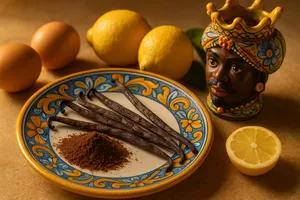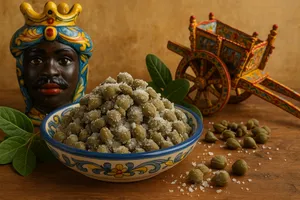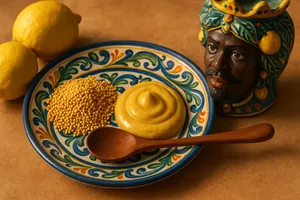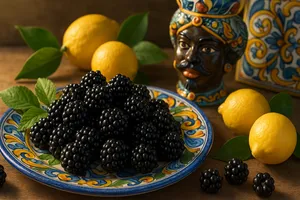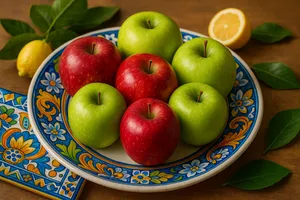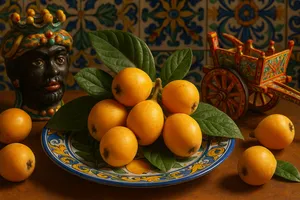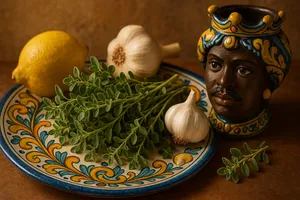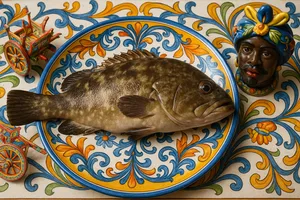Overview
Borage, known in Sicily as “vurrania” or “vurraina” depending on the area, is a wild herb widely spread across the island, where it grows abundantly in fallow fields, along roadsides and in vegetable gardens. This plant, with its distinctive hairy leaves and beautiful star-shaped flowers in shades of blue and violet, has for centuries been an important element of Sicilian peasant cookery and traditional herbal practice.
Belonging to the Boraginaceae family, this hardy and generous plant perfectly embodies how traditional Sicilian cuisine has long valued the spontaneous resources of its landscape. Its delicately flavoured leaves, faintly reminiscent of cucumber, feature in numerous recipes from rural tradition, from fillings to frittatas, from soups to savoury pies.
Characteristics
Borage (Borago officinalis) is an annual herbaceous plant that can reach a height of 40–80 centimetres. It is easy to recognise thanks to its oval, fleshy leaves covered in a dense, bristly hair. The stem is likewise hairy and branched, with a succulent texture.
The flowers, which bloom from April to September, hang in drooping clusters and have a characteristic five-pointed star shape in an intense blue-violet, at times tinged with pink. Both the leaves and the flowers are edible, although in cookery it is mainly the young leaves that are used, as they have a more delicate flavour and a less coarse texture.
The flavour of borage is distinctive: slightly savoury with herbaceous notes and a hint of cucumber in the aftertaste. The texture is fleshy and, once cooked, becomes soft and silky, losing almost all the hairiness that characterises it when raw.
Seasonality and harvesting
In Sicily, thanks to the mild climate, borage is available almost all year round, but the best periods for harvesting run from late winter to late spring, and then again in autumn. During these months, the leaves are more tender and flavourful.
Harvesting should focus on the youngest and tenderest leaves, those near the top of the plant, avoiding the older basal leaves, which tend to be tough and fibrous. It is important to harvest borage far from busy roads or land treated with pesticides, favouring clean countryside areas.
The leaves should be picked early in the morning, while still fresh with dew, and used preferably the same day. The flowers, if intended for decorative use or in salads, should be gathered when fully open.
Nutritional characteristics
Borage is a very light vegetable, with around 20–25 calories per 100 grams. It is rich in water (over 85%) and provides a good amount of fibre, beneficial for digestion and intestinal function.
From a vitamin standpoint, it is a good source of vitamin A, important for eyesight and skin, vitamin C, with antioxidant properties and immune support, and B-group vitamins. It also contains notable quantities of minerals such as calcium, potassium, iron and magnesium.
Borage is known for being particularly rich in polyunsaturated fatty acids, especially gamma-linolenic acid (GLA), found mainly in the seeds and in the oil extracted from them. In Sicilian folk medicine it was considered purifying, diuretic and refreshing.
Culinary use
In Sicilian culinary tradition, borage appears in numerous preparations that highlight its delicate flavour.
Borage frittata
One of the most classic preparations is the frittata, in which boiled and squeezed leaves are mixed with eggs, grated cheese, salt and pepper, then cooked in a pan until golden. Onions or other wild herbs are often added.
Borage soup
Rustic soups with borage are typical dishes of Sicilian peasant cookery. The leaves are cooked in broth with potatoes, legumes, pasta or grains. In some areas, a borage and ricotta soup is prepared, particularly creamy and delicate.
Fillings
Finely chopped borage is a classic ingredient for the fillings of ravioli, cannelloni and tortelli. It is mixed with fresh ricotta, eggs, grated cheese and nutmeg, creating a soft, fragrant filling. It is also used to stuff vegetables.
Savoury pies
Boiled and squeezed leaves are perfect for rustic pies and baked preparations. They are mixed with ricotta, eggs and cheese, then enclosed in a pastry crust and baked. These dishes are typical of Easter and spring festivities.
In the pan
Simply sautéed in a pan with garlic, extra virgin olive oil and chilli, borage becomes a quick and flavourful side dish. Some variations include the addition of cherry tomatoes or olives.
Flowers in salad
Borage flowers, with their delicate and slightly sweet flavour, can be used fresh to decorate and enhance mixed salads, adding both colour and a distinctive note.
Preparation and cleaning
Preparing borage requires some care due to the hairiness of its leaves and stems. The leaves should first be washed thoroughly under running water to remove soil and impurities. If you have particularly sensitive skin, gloves are advisable, as the hairs can be mildly irritating.
Remove the toughest stems and any damaged leaves, keeping only the tender ones. Borage should then be boiled in plenty of salted water for 5–10 minutes, until the leaves turn soft. The hairiness almost completely disappears during cooking.
After boiling, it is important to drain borage well and squeeze it by hand to remove excess water, which would otherwise make preparations too wet. At this point it can be chopped and used in various recipes.
Buying tips
In Sicilian markets, especially neighbourhood and farmers’ markets, fresh borage can be found in spring and autumn, sold in bunches. The leaves should be a vibrant green, firm and free from yellow or brown spots, which indicate deterioration.
It is best to choose bunches with small or medium leaves, as these are more tender. Very large leaves may be tougher and more fibrous. The stem should be firm and fleshy, not wilted.
If foraging wild borage, it is essential to be certain of the plant’s identification and to avoid polluted areas, roadsides or chemically treated land.
Storage
Fresh borage keeps in the refrigerator for up to 2–3 days, wrapped in a damp cloth or paper bag in the vegetable drawer. It should not be washed before storing, only just before use, as moisture accelerates deterioration.
To keep it longer, it can be boiled, squeezed thoroughly and frozen in portions. In this way it lasts 3–4 months and is ready to use for fillings and other preparations. Cooked borage keeps in the refrigerator for 2–3 days in an airtight container.
Precautions
Although borage is traditionally consumed in many Italian regions, including Sicily, it is important to note that excessive and prolonged consumption is not advised. The plant contains pyrrolizidine alkaloids which, in large quantities, may be harmful to the liver.
For this reason, borage should be eaten in moderation and as part of a varied diet. Cooking reduces the presence of these substances. Consumption is not recommended for pregnant or breastfeeding women, or for those with liver conditions.
Pairings
The delicate flavour of borage pairs beautifully with fresh cheeses and ricotta, which balance its mildly herbaceous note. Classic Sicilian pairings include eggs, potatoes, garlic, onion and other wild herbs.
Grated nutmeg is a spice traditionally used in borage fillings, enhancing its flavour. Lemon, with its acidity, creates a pleasant contrast. As for wine, fresh and aromatic Sicilian whites such as Grillo or Catarratto are recommended.
Curiosities
The name “borage” likely derives from the Arabic “abu araq”, meaning “father of sweat”, a reference to the plant’s sudorific properties ascribed in ancient medicine. In Sicily, the dialect name “vurrania” or “vurraina” probably shares the same Arabic root, a testament to the island’s long Islamic rule.
In Sicilian folk tradition, borage was considered a lucky plant, and it was said that carrying a borage flower brought courage. Not surprisingly, old sayings told that “A vurrania ’nta sacchetta, sapi di primavera e porta allegria” (Borage in your pocket smells of spring and brings joy).
The beautiful blue flowers of borage were used by Sicilian women to prepare calming and refreshing decoctions, especially appreciated in the hot months. They were also added to wine to flavour it and, according to popular belief, to soothe melancholy.
In folk medicine, fresh borage leaves were applied as poultices on boils and skin inflammations for their supposed emollient and anti-inflammatory properties. Leaf infusions were considered purifying and drunk during seasonal changes.
Today, borage is enjoying a gastronomic revival, appearing on the menus of restaurants that celebrate wild herbs and the forgotten flavours of Sicilian tradition. Chefs are reinterpreting ancient recipes, presenting borage in modern dishes that highlight its organoleptic qualities.


